Abstract
Passengers’ trust in Shared Autonomous Vehicles (SAVs) can be affected by different factors, such as their attitudes toward new technologies and perceptions of the vehicles’ reputation. While the existing literature has begun to explore these issues, there is limited research investigating how industrial design in SAVs can enhance passengers’ trust levels. To address this gap, this study responds to the central question: How can passengers’ trust in the vehicle itself and in fellow passengers be enhanced through design intervention? This question conceptualises trust in the vehicle and trust in strangers as an integrated trust issue within the SAV context. To fill this gap, this study adopts a project-grounded methodology. The design work is guided by five trust principles: anthropomorphic design, a defensible space, system transparency, personalisation features, and a restorative environment. Drawing on insights from an auto-ethnography of current ride-sharing services, these principles are further explored and applied to identify design opportunities for both the physical and digital elements of SAVs. The final conceptual SAV design demonstrates how different design elements can be orchestrated to engender user trust. The outcome contributes to ongoing design practices and helps researchers and designers better understand trust design for SAVs.
1. Introduction
With advancements in fully autonomous technology (Level 5), it is anticipated that SAVs could potentially become a reality when this autonomous driving technology is combined with on-demand shared mobility services (e.g., Uber, Didi) [1]. SAVs have been trialled in a number of cities around the world but are only provided on a commercial basis in certain areas, such as Waymo One (Waymo LLC, Mountain View, CA, USA) and EZ10 (EasyMile, Toulouse, France) [2].
SAVs integrate autonomous vehicles (AVs) and shared mobility, offering benefits such as reduced pollution, improved safety, and cost efficiency [1,3]. However, they may also increase vehicle numbers and service wait times [4]. Given their limited real-world deployment, their full impact remains uncertain. To maximize benefits, SAVs need to be shared simultaneously between strangers.
Although AV technology and ride-sharing schemes are increasingly implemented, little is known about whether passengers prefer to ride alone or share space with strangers. SAVs offer potential advantages, such as carpooling, that already exist but are not widely adopted. While many technical challenges have been addressed, broader adoption is still limited due to social barriers, particularly issues of trust.
Studies have shown that distrust in automated systems and discomfort with unfamiliar co-riders, especially in the absence of an authority figure, are significant obstacles to SAV implementation [5,6,7]. A strong correlation was found between trust in the vehicle and trust in strangers, as the passengers’ trust level in strangers may be affected by the low trust in a vehicle without a human driver [8,9].
Discussions about designing trustworthy SAVs often emphasise driving technology and human–machine interaction (HMI), particularly in the automation literature [10]. However, these discussions frequently prioritise technological aspects or are constrained by commercial confidentiality. In addition to technology, vehicle design features also significantly influence users’ trust. Yet, limited research has examined how industrial design can address trust issues, both in relation to the vehicle itself and among co-passengers.
This study assumes a future scenario in which SAVs are technically capable of ensuring safety for both co-passengers and pedestrians, in line with the development of fully autonomous Level 5 vehicles. Therefore, the focus of this research is not on the technical implementation of safety systems, but on how industrial design, including form, space, interface, and app features, can enhance users’ perception of trust when using SAVs. Specific technological and ethical considerations, such as the prioritisation between pedestrian and passenger safety, are considered to be beyond the scope of this study.
To avoid an overly broad scope, the context of SAVs in this study represents the envisioned end state of SAVs as currently perceived. The focus is on design challenges related to passengers’ trust issues within a hypothetical future scenario where multiple strangers share space during the use phase in an SAV. The design work is guided by a set of key assumptions:
- SAVs are defined as fully autonomous vehicles (Level 5) with no onboard operator.
- From a technological perspective, SAVs are assumed to ensure safety for both passengers and pedestrians.
Given the significance of trust in the adoption of SAVs, this study addresses how to enhance passengers’ trust through design practice. It focuses on two primary dimensions: trust in the vehicle and trust in fellow passengers. The research responds to a gap in the design literature by investigating how industrial design can mitigate trust-related challenges in SAVs. To achieve this aim, the following objectives are intended to be fulfilled:
- To discover the potential challenges and opportunities of trust design for future SAVs.
- To develop a conceptual design solution for future SAVs through design practice that could engender trust between the vehicle and fellow passengers.
2. Methodology
The research methodology and progression were guided by the project-grounded design methodology and the double diamond process [11,12]. The research framework (Figure 1) illustrates the linear process of how project-grounded research was applied to the process, which includes the discovery, defining, design, and delivery phases.
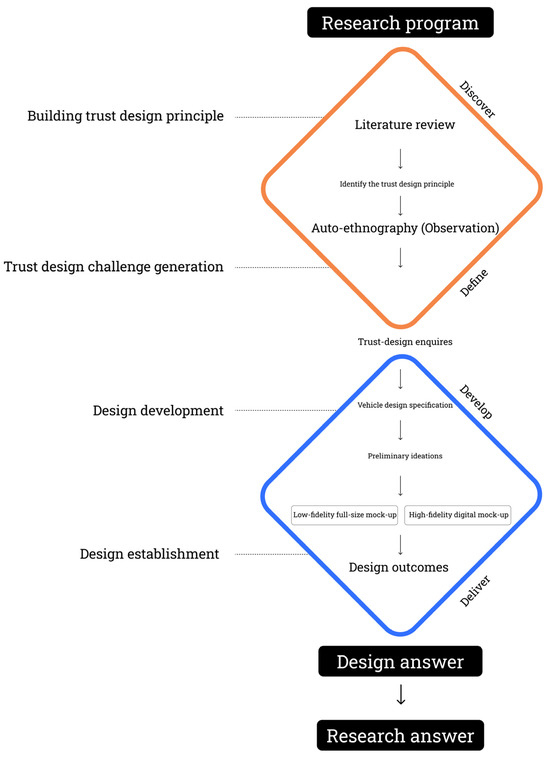
Figure 1.
Overall research framework.
The methodology is based on the idea that arguments can be built through the act of designing, and that knowledge can be derived from artefacts created through the design process [13,14]. The research approach integrated research methods and design tools from the industrial design field and applied design principles throughout the research process.
Through a review of the literature, a set of design principles was established based on selected trust design theories. Then, through auto-ethnography, this study further explored current experiences with ride-sharing vehicles. By synthesising insights from trust design principles and auto-ethnography, this study identified a series of trust design enquiries that needed to be addressed.
The design analysis encompassed the design processes of the studio project, including sketching and creating physical and digital mock-ups. The final design was refined through reflections on different types of prototypes and design iterations, and how they delivered trust-building techniques through the design of a vehicle.
2.1. The Discovery and Defining Phases
Given that SAVs are not yet widely used in the market, discovering trust challenges directly related to SAVs is limited by the current user experience. Initially, trust design principles were identified to guide solutions for specific issues. These principles served as a foundation from theory to practical design. Defining these principles involved selecting widely discussed trust design theories that could guide the design of SAVs.
To better understand trust challenges, auto-ethnography was used to collect qualitative data on passengers’ trust issues in current ride-sharing services. This method helped the authors gain insights into personal experiences and other passengers’ natural behaviour during the trip, offering a deeper understanding of broader cultural phenomena. These insights informed the development of trust design principles and potential trust design challenges for future SAVs. Then, the trust design enquiries were identified, which represented the design questions that needed to be answered through design practice. Accordingly, a product design specification was created to establish criteria and parameters for defining the project’s scope and enabling a checking procedure at the project conclusion.
2.2. The Development and Delivery Phases
The development and delivery phases involved transforming design ideas into tangible outcomes. In the development phase, the SAV cabin layout and concept were defined, followed by sketching to refine the exterior and interior designs.
To bring the 2D design concept into a 3D form, low-fidelity full-size physical mock-ups were created. These mock-ups allowed for the assessment of the scale, proportions, and ergonomics of the SAV. Then, digital models were built to further analyse the design. The Blender software version 3.0 was used for 3D modelling, allowing for detailed digital representations.
Finally, the design was delivered through a hi-fi digital model and a low-fi physical mock-up, demonstrating the final design’s visual and spatial qualities. It represented the completion of the double diamond design process. The design artefacts represented the design answer and also served as a research answer for the study.
3. Trust Design Enquiries
3.1. Building Trust Design Principle
The goal of this research project is to address trust in vehicles and fellow passengers in SAVs, so the selection of trust design principles should be relevant to these two aspects. The literature review highlighted six important design theories that influence trust in automation: system transparency, a defensible space, anthropomorphic design, personalisation features, hedonic features, and a restorative environment [15,16,17,18]. However, hedonic motivation and enjoyable features may have less impact on the user’s trust level in SAVs because users may become less excited as they become familiar with this new type of vehicle [17]. Additional enjoyment features may have limited functionality in SAVs during shared trips, specifically during short trips. Therefore, hedonic features were considered unsuitable as a trust design principle in this project and the remaining five principles were carried forward:
- Anthropomorphic design: Design appropriate human-like characteristics for SAVs to enhance the vehicle’s affinity.
- Defensible space: Design territoriality in shared spaces for SAVs to enhance control over the space.
- Transparency system: Transparency system: Enhancing users’ awareness of the status of SAVs and ensuring a clear comprehension of the journey.
- Personalisation feature: Provide passengers with useful and essential personalised features when using SAVs.
- Restorative environment: The use of design to enhance passengers’ positive emotions when sitting in SAVs.
This project applied these design principles physically and digitally. For example, the transparency system is an important principle for the digital layers for design interface information provision, and a restorative environment can be applied to the physical vehicle.
As trust-building is a dynamic process, and users’ trust levels vary across different phases of their journey, it is necessary to consider different phases of the user’s journey that could impact trust design, including before, during, and after rides [19,20]. Different design elements of SAVs play different roles in different use phases. For instance, before the use phase, the exterior is important for building trust as the passenger builds their first perception of the vehicle, while during the use phase, the interior plays a major role in trust-building. Thus, both exterior and interior design were considered for this project. Moreover, interior and exterior interface features were designed to support the main concept. Accordingly, the guidance of the design principles in the SAV design is shown in Figure 2.
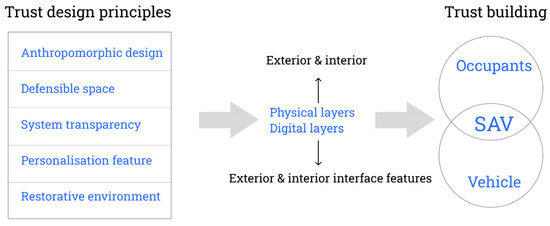
Figure 2.
Trust design principles: project structure.
3.2. The Auto-Ethnography
Auto-ethnography is a qualitative method that allows the researcher to become a full insider to the study, providing an empathetic, emotional, and first-hand understanding of experiences that cannot be achieved through observation and secondary research alone. This study primarily focused on ride-sharing services that naturally integrate passengers from different journeys. The authors randomly selected routes corresponding to specific activities at certain times, such as travel from urban to rural areas. Observations were conducted over a defined period, consistently in the morning (7 a.m.) and at night (12 a.m.), until data saturation was achieved and no new perspectives emerged.
To ensure the comfort and privacy of fellow passengers, the observations were conducted after each trip rather than during it, in order to avoid any discomfort or perception of being monitored. In this study, a travel diary was used to collect data regarding vehicle design, the authors’ personal thoughts and feelings, as well as insights gained from observing the behaviour of strangers.
Following the data collection phase, the findings were synthesised and categorised according to selected design principles, in order to better understand the potential design challenges that may arise in the future context of SAVs. For example, based on observations of stranger behaviour, potential user requirements for defensible space in future SAVs were identified, while insights related to the aesthetics of the vehicle’s exterior and interior provided hypothetical inputs for restorative environments and anthropomorphic features. Furthermore, by better understanding how the physical layout of the vehicle, the seating arrangement, and the presence of shared amenities or technological features affect the passenger experience, designers can gain insight into how future SAVs might be improved to foster trust.
The authors successfully recorded eight ride-sharing trips with strangers, and after the fourth trip, the user behaviour patterns remained consistent. This could be attributed to the fact that many trips occurred in urban areas, where passengers tended to exhibit similar behaviour during rides. These findings suggested that data saturation was likely achieved at this point. This aligns with recent research indicating that, in studies with focused topics and relatively homogeneous participants, data saturation can often occur within as few as 7 to 10 cases [21]. Table 1 shows a summary of important contextual parameters for each recorded trip.

Table 1.
Summary of successful shared trips in auto-ethnography.
The analysis of the insights was based on five trust design principles, which reflect the thematic analysis methods for qualitative research [22]. These insights, along with the insights into strangers’ behaviour, are synthesized in detail as follows:
3.2.1. Findings Related to Anthropomorphic Design
The aspect of anthropomorphic design in current shared car designs is difficult to define. This is because current shared cars are based on various types and brands of vehicles driven by individual drivers, as observed in Melbourne, Australia. There may be differences in other countries. For example, in China, some shared car platforms have fixed vehicle models and brands, such as the D1 from Didi, which are specially designed shared cars.
Currently, shared vehicles are mostly regular private cars, resulting in varying designs. In terms of anthropomorphic design, there are significant differences. It is evident that due to the distinct design languages employed by different brands, the intended purpose of anthropomorphic feeling in vehicles is different. For instance, sports cars may adopt aggressive facial expressions to convey a sense of powerful performance, whereas luxury vehicles often incorporate more serious expressions to evoke a sense of stability.
According to the authors’ personal observations, anthropomorphic design elements on the exterior of cars have little impact on the perception of the vehicle itself, especially at night when it becomes difficult to identify the vehicle. Even in the case of purpose-built shared vehicles such as the D1, the front face expression tends to appear more sporty rather than approachable. In this regard, the authors believe that there is significant space for development in anthropomorphic design for SAVs, in the absence of a driver. Anthropomorphic design elements can enhance users’ recognition and understanding of the vehicle, increase the affinity between humans and vehicles, and thus increase trust [23].
3.2.2. Findings Related to Defensible Space
The theory of defensible space primarily emphasizes the importance of individuals controlling their personal space in shared environments. From the observation of strangers’ behaviour, it can be assumed that users strongly desire personal space when sharing a vehicle with strangers, as they tend to avoid close proximity and interaction with unfamiliar passengers. This observation is supported by the authors’ experiences. In multiple instances, passengers already seated in the back row near the window did not voluntarily move when the authors attempted to board from that side, especially at night. So, the authors had to enter the vehicle from the opposite side, highlighting the significance of personal space control.
Looking ahead, in future scenarios where passengers ride in SAVs without drivers, there may be increased concern about controlling personal space due to the absence of an authority figure, potentially impacting feelings of safety. Additionally, in a specific experience, when the vehicle paused to pick up a second passenger, it remained stationary on the roadside for several minutes without the passenger arriving. Given the night-time setting, the authors became apprehensive about the possibility of the passenger unexpectedly opening the car door and entering, which could compromise feelings of safety. This scenario further highlights the importance of defensible space in shared vehicle design.
3.2.3. Findings Related to Transparency System
Transparency was a significant factor in increasing trust in AVs within the wide research area of trust [18,24]. In the shared vehicle experience at the time, transparency-based designs were prominently observed, primarily reflected in the design of mobile apps. These apps provided real-time monitoring of journey status, including when and where other passengers joined the shared journey.
From the authors’ experience during this study, there was a need to constantly observe the map in the app to determine the journey progress, which might have been one of the reasons why people used their phones while riding in a shared car. There were limitations, as this information was primarily displayed on the user’s mobile phone.
As mentioned earlier, shared vehicles were rarely specifically designed for shared journeys, so there were relatively few designs aimed at increasing transparency in the vehicle itself, including its exterior and interior. When there was a driver present in the vehicle, they could provide information such as reminders about reaching the destination or updates on traffic conditions ahead. Nevertheless, when there was no driver in the vehicle, the design at the time might have caused problems for users in understanding the trip if they did not use their phones.
Another important finding was that boarding passengers had difficulties identifying the positions of other passengers in the vehicle. This could lead to issues when entering the car, particularly at night. Therefore, it was essential for the authors to always check where other co-riders were seated in the vehicle when getting in. Additionally, the authors needed to mentally prepare for the possibility that new people would join the ride when picking up other passengers.
3.2.4. Findings Related to Personalisation Feature
Current observations and the authors’ own experiences suggest that personalisation is largely absent in the design of shared vehicles. The only notable implementation appears in ride-hailing apps, where users can choose between vehicle types based on limited preferences.
There are several design limitations in the vehicles themselves, because they are not specifically designed to be SAVs. It can be inferred that, for the current scenario, users may not have significant demands for personalized design, especially on short trips. According to the observations, it appears that users may have preferred selecting their own seats, as individuals had specific preferences. For example, most passengers preferred sitting by the window. In this regard, the application of personalized design in future SAV designs needs to consider potential user needs and apply appropriate personalised features to increase user trust.
3.2.5. Findings Related to Restorative Enviroment
In the design of shared vehicles, the lack of models specifically tailored for ride-sharing made it challenging to assess the atmosphere provided by vehicle design. As the vehicle type depended on the passengers’ requirements, passengers also had opportunities to book luxury brands, which might have provided a more spacious and comfortable seating environment. Due to system matching and the concentration of shared vehicles among a few popular brands, the ride experiences were largely similar. For example, successful ride-sharing or personal ride-hailing journeys often involved black and white sedans, hatchbacks, or SUVs, and it was apparent that sedans had limited headroom compared with SUVs.
Although the authors used different types of vehicles based on random system matching, it was difficult to uniformly determine whether the vehicles at that time could create a restorative environment. The shared nature of these vehicles added to this challenge, as uncertainty about passenger behaviour could impede the establishment of such an environment. For instance, some users may dirty the seats. Therefore, unless a luxury car is booked that provides a higher baseline of cleanliness, comfort and space, most ride-sharing vehicles cannot guarantee that all vehicle types offer a restorative environment.
3.3. Summary of Trust Design Enquiries
Table 2 presents a framework for trust design enquiries, derived from synthesising findings from auto-ethnography and trust design principles. While some findings did not directly correspond to design principles, they provided valuable insights from a design perspective. Therefore, these trust design enquiries represent potential challenges for trust design in SAVs and offer guidance for the design development phase.

Table 2.
Summary of trust design enquiries.
4. Vehicle Design Package Definition
4.1. Design Specifications
AVs are currently the subject of extensive research and have been deployed in specific cases, such as Waymo. However, there are still few examples of Level 5 SAVs operating in broader public contexts. As current commercial AVs emphasise the advantages brought by the technology itself, there is no clearly unified definition of the design specifications for SAVs. The effective development of SAVs has to consider various aspects and facilitate the synthesis of partially conflicting requirements and boundary conditions to prevent the design from becoming overly broad. The following design specifications are based on the literature and auto-ethnography:
- The SAVs discussed in this review are primarily intended for use in urban areas.
- These SAVs refer only to publicly owned ride-sharing services, excluding those privately owned for individual use.
- The SAVs in this project align best with ride-pooling: a public option balancing comfort and utility.
- To balance potential user demands and project goals, as well as to ensure that SAV can accommodate different types of users, this project refers to a six-seat capacity [25].
4.2. The Vehicle Package Concept
Through the ideation analysis, the authors identified the initial package concept, as shown in Figure 3. This represents the most common seating arrangement found in current passenger cars. All seats are oriented to face forward. This arrangement provides a good field of view, which can increase passengers’ trust during the journey by enhancing visibility of the road situation ahead. In addition, it could help to reduce motion sickness [26].
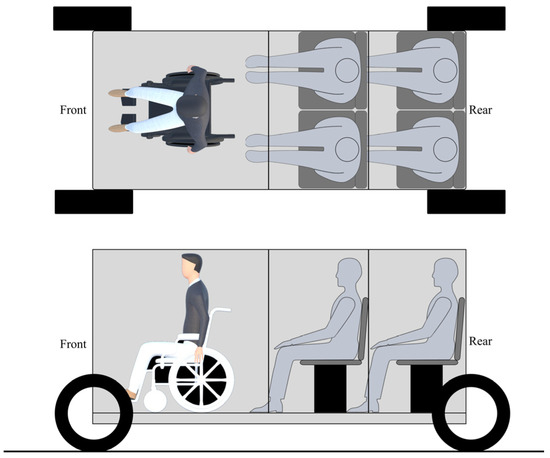
Figure 3.
Vehicle package concept.
Although this seat arrangement compromises convenience for interaction among group passengers, based on the authors’ observations of current ride-sharing vehicles, a face-to-face seating configuration for passenger interaction is unnecessary, particularly in urban areas. Compared with concepts such as face-to-face seating arrangements, this layout could also reduce the size of the vehicle by flexibly utilising legroom space, thereby shortening the vehicle’s overall length.
Another potential advantage of this layout is that it could provide a flexible solution for both individual and group users. The front space is designated as a group area (for two or three passengers) that can accommodate either small groups or wheelchair users.
Allocating the front of the vehicle for wheelchair users reflects an inclusive design approach. Rather than placing them at the rear, this layout promotes dignity, equality, and a sense of inclusion. In addition, the front seating offers a better external view, which could be particularly valuable for vulnerable users.
It is important to note that the current spatial configuration does not represent the final dimensions of the SAV. These dimensions were progressively refined during the design development phase.
5. Design Development
5.1. SAV Exterior Ideation
The SAV exterior ideation process begins with the side view to establish the tone of the exterior design, as the side view includes all the necessary determinants of design: the vehicle silhouette, proportions, and the overall image of the vehicle [27,28].
Figure 4 illustrates side-view ideation sketches that aim to explore the vehicle’s silhouette and form language. This process helps define the overall exterior direction, combining one-box and three-box features. By moving the A-pillar forward, the layout leverages EV architecture to maximise cabin space while referencing visual cues from conventional taxi forms (e.g., London taxis) (Figure 4a). It aligns with the MAYA principle and aims to provide a feeling of familiarity for people [29,30].
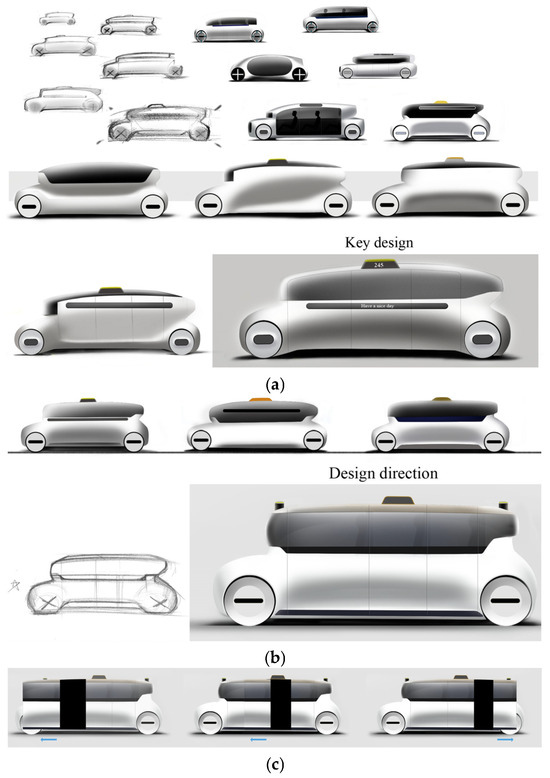
Figure 4.
SAV exterior side view ideation: (a) side view initial sketches; (b) side view of the final design direction with closed doors; and (c) an illustration of the door opening mechanism.
The selected concept was further refined through proportional and formal development (Figure 4b). To reduce boarding conflicts and support perceived safety, the concept incorporates six individual sliding doors to facilitate boarding from different directions for different users (Figure 4c).
The second stage of exterior ideation focuses on the front and rear faces. The front face, as the first point of contact, follows the anthropomorphic design principle to shape initial impressions [31]. Graphic elements are used to trigger emotional responses, leading people to associate positive terms like “friendly” with the vehicle [32]. Figure 5 presents sketches of the front and rear faces. The features formed by the contours of the front bumper, combined with the headlight graphics, create a smile-like emoji. This design aligns with the literature’s expectations of increased passenger trust through anthropomorphic features.
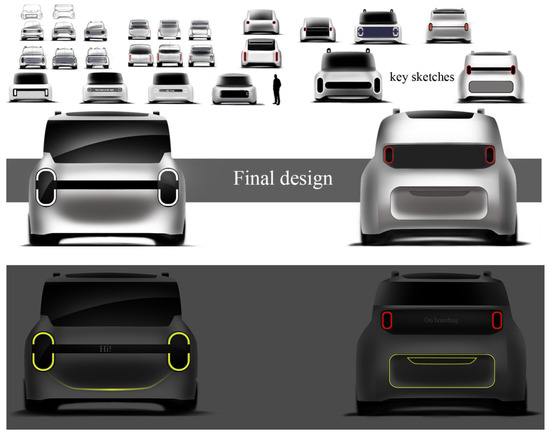
Figure 5.
Front and rear-view ideation sketches.
To meet the system transparency requirement, the front screen is designed to span between the two headlights, creating space for potential information display. This integration allows the headlights and screen to span across the front face, thereby increasing the car’s visual width. Similarly, the rear design maintains the same style as the front, integrating the taillights and rear screen to create a cohesive visual feature that aligns with the front face.
The above design work was eventually integrated into perspective views to further refine the overall design. As shown in Figure 6, the final design represents a complete exterior that incorporates features from previous sketches to address trust-related design requirements.

Figure 6.
Exterior design concept.
5.2. SAV Interior Ideation
Figure 7 presents the initial interior concept sketches. The core concept is the flexible partitions that allow passengers to create either private or temporary group spaces to ensure defensible space. Each space is equipped with a “Main Screen” that displays journey information, ensuring situational awareness in the absence of a driver. Additionally, a “Space Control Screen” allows passengers to adjust relevant settings for their space.
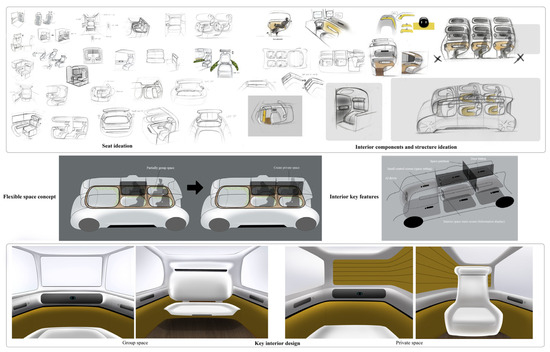
Figure 7.
Interior ideation sketches.
Following the initial idea, key interior concepts were refined by integrating the exterior’s organic form language to ensure a cohesive and minimal appearance (Figure 8). As observations showed that users rarely adjust seats during short trips, fixed configurations could better preserve space and minimise disruptions for different users. Thus, the seat design emphasises form rather than flexibility. An integrated, enveloping structure offers sofa-like comfort, aiming to create an “embrace” feeling, which reinforces a home-like aesthetic, fostering emotional affinity and trust [33].
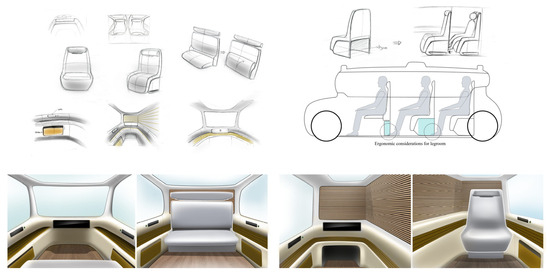
Figure 8.
Interior final design concept.
The final interior design promotes micro-restorative experiences through natural elements, warm colours, and soft textures, aligning with restorative environment principles [34]. These features support relaxation and positive emotions, enhancing passengers’ sense of security and overall trust in the SAV during shared travel.
5.3. Mock-Up Building and Design Refinement
5.3.1. Physical Mock-Up
The full-size mock-up was a low-fidelity model used to quickly confirm the feasibility of the interior concept, determine whether passengers could fit comfortably, and identify the rough dimensions of the final SAV to the nearest 100 mm. Side-view tape drawings were used to commence the construction of the full-size mock-up [35]. The side-view tape drawing was based on the final exterior concept. During this process, the initial dimensions of the SAV were determined to be approximately 5000 mm in length, 1700 mm in width, and 1660 mm in height, meeting the defined segment criteria (the dimensions are similar to a Toyota HiAce (Toyota, Toyota, Japan) and aligning with the exterior design proportions.
Building upon the tape drawing, a low-fidelity full-size mock-up was constructed, as shown in Figure 9. Figure 10 illustrates the overall fit between the 5th percentile female and 95th percentile male manikins and the seat design, confirming that the dimensions are suitable for the final seat design.
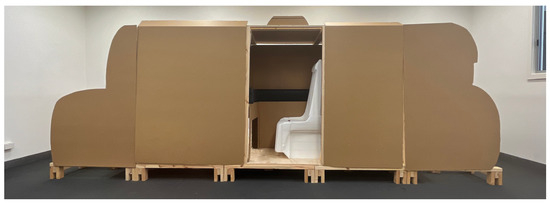
Figure 9.
Low-fi mock-up.
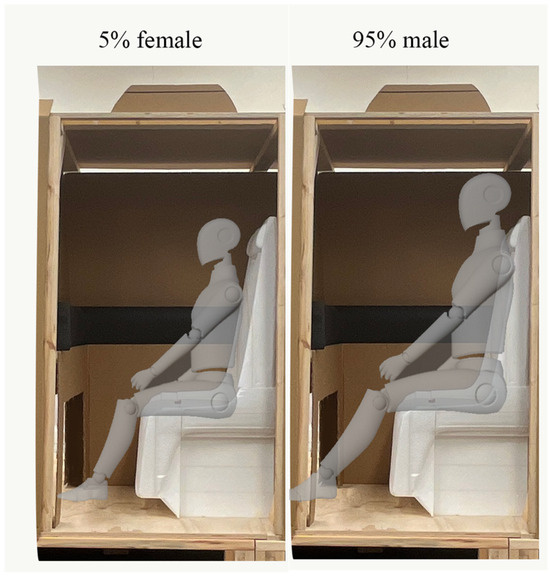
Figure 10.
A 5% female and 95% male manikin overlay with the seat mock-up.
Figure 11 shows a full-scale test rig used to assess the mock-up’s usability for specific user proportions. It includes a floor, partitions, and an office chair similar in size to the seat concept, simulating private space. Two participants, 1750 mm and 1870 mm tall (representing the 95th percentile female and male), performed activities such as standing, sitting, boarding, and disembarking (Figure 11a).
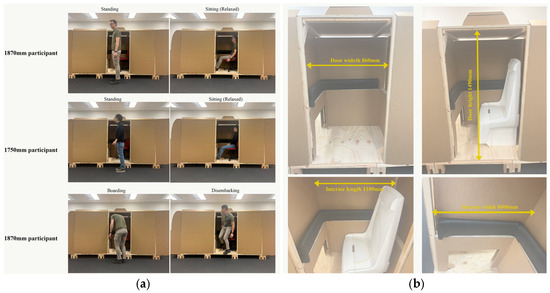
Figure 11.
Full-scale interior test rig: (a) test of performed activities; (b) mid-space rough dimensions.
The interior accommodated both participants in a relaxed sitting posture, with 860 mm in width and 1100 mm in length proving sufficient when legroom is provided. However, boarding and disembarking revealed limited headroom for the 1870 mm participant. Though we could increase the vehicle height to ensure fully upright entry, it may impact the proportion of the vehicle. A door height of 1490 mm balances usability and visual design, aligning with minivan standards. The final design can include an appropriately shaped roof opening to prevent head contact with the ceiling. The mock-up effectively guided the interior spatial layout and confirmed that the private middle space can accommodate most users (Figure 11b).
5.3.2. Digital Mock-Up
Drawing from the spatial dimension insights gained through the physical mock-up, the authors utilised the Blender software to create a 3D digital model representing the final design. During the creation of the digital model, it was evaluated with three digital manikins (a wheelchair user, a 95th percentile male, and a 5th percentile female) [36,37].
As shown in Figure 12, the front group space is also used for wheelchair users. To ensure they have enough space, the “Main Screen” is designed to be flexible, so when they enter the space, it can move forward to provide more space, in case of a clash with the wheelchair. While mechanical design is out of the scope of this study, the design of the ramp was resolved to meet ramp ratio requirements (1:4). The final SAV incorporates mid-size tires (R = 660 mm) [38]. In summary, the final dimensions of the SAV are as follows:
- Exterior dimension
Length: 5000 mm
Width: 1800 mm
Height: 1880 mm (total height), 1780 mm (excluding the top sign)
Wheel base: 3990 mm
- Front space
Maximum interior length: 1700 mm
Maximum interior width: 1500 mm
Maximum interior height: 1500 mm
- Middle private space
Maximum interior length: 1100 mm
Maximum interior width: 860 mm
Maximum interior height: 1500 mm
- Rear private space
Maximum interior length: 1440 mm
Maximum interior width: 860 mm
Maximum interior height: 1500 mm
Research on seating postures and proxemics in SAVs remains limited. Given the typical use of SAVs in urban, short-distance scenarios, user behaviour is assumed to be similar to that in current ride-sharing vehicles, focusing primarily on leisure and phone use rather than sleeping. Therefore, features such as fully reclining seats are excluded from the design scope.
This project defines SAVs as six-seater vehicles positioned between medium-sized cars and vans. To balance comfort and spatial efficiency, the seat geometry is based on anthropometric data [36], primarily targeting users from the 5th percentile female to the 95th percentile male. The key dimensions are as follows:
- Popliteal height: Approximately 400 mm, similar to chairs or couches.
- Seat depth: Set at around 400 mm, balancing support and compactness.
- Seat width: 550 mm, to accommodate larger users and clothing allowance.
- Sitting height: Based on 965 mm for a 95th percentile male, to be optimised through roof clearance.
- Backrest angle: Set at 110°, a widely adopted standard value suitable for short trips and consistent with seat requirements in most subways, trains, and buses.
Due to the complexity of defining interior boundaries, the maximum dimensions for the interior indicate the distance to the extreme boundaries when each space is fully enclosed. Although there is some margin of error, it provides a clear indication of the proportion occupied by each space in this SAV.
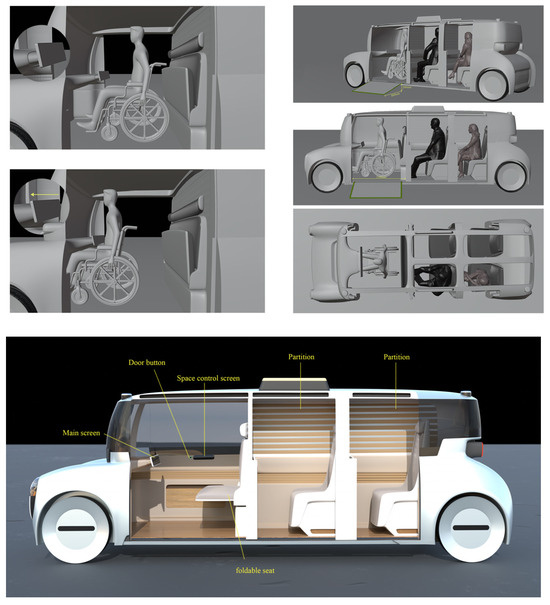
Figure 12.
Final SAV digital model.
6. Design Result
6.1. Anthropomorphic Design
Figure 13 represents the final exterior design. Unlike many concept designs for AVs that adopt a one-box type similar to buses, this concept maintains proportions that are familiar to users, resembling traditional taxis. This design intends to help users distinguish the SAV from buses through exterior visual cues. This enhances user trust by incorporating familiar visual elements that foster a sense of affinity, which may contribute to enhanced user trust.
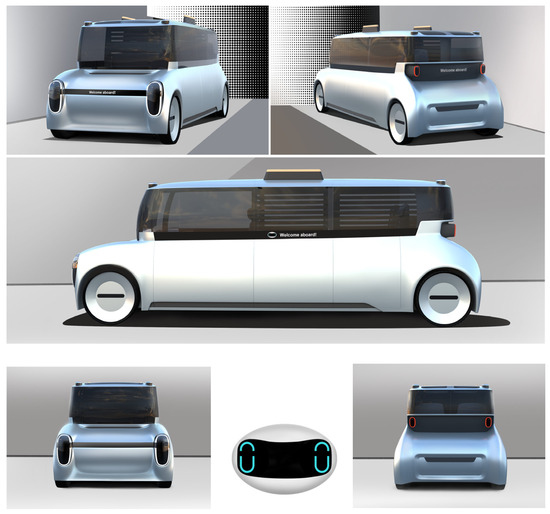
Figure 13.
Exterior design outcomes for SAV.
The design choice of form language emphasises a concise and organic aesthetic, with smooth and fluid surfaces and minimal sharp edges. By doing so, it seeks to foster passengers’ sense of affinity when approaching the SAV, thereby potentially increasing their perceived sense of trust.
The vehicle’s design emphasises anthropomorphic features in the front face, which are crucial for passengers’ initial impressions before entering. These features are primarily conveyed through the design of the headlights, which use large-sized, vertically segmented lights and concise graphical elements to create a friendly, approachable appearance and enhance the vehicle’s recognisability, especially at night or from a distance. The traditional grille is designed as a screen to display relevant information. This design is expected to elicit positive emotional responses, which could support the development of trust in the vehicle. A similar approach is applied to the rear face design.
The “AI Driver” is developed from the front face’s graphic language. The final “AI Driver” concept is applied to physical features (front and rear face) and digital elements (exterior and interior interfaces). For instance, on the front face, information is provided through the central digital screen. In the vehicle’s side view, the “AI Driver” will appear in digital form on the side screen to interact with passengers at each door, such as displaying greetings when they approach. This approach aims to reinforce the anthropomorphic features of the SAV through unified visual cues.
The final exterior design integrates anthropomorphic elements across the vehicle’s physical and digital touchpoints. This unified design seeks to offer an anthropomorphically mediated user experience even before entering the vehicle, thereby addressing trust-related design considerations associated with the exterior’s anthropomorphic features.
The proposed interior feature that responds to anthropomorphic design principles is the “AI Driver,” which is integrated into the interior HMI. Following the same design as the exterior, the “AI Driver” is displayed on the “Main Screen” inside the SAV, acting as a digital agent to interact with future passengers through greeting and voice control. The final design includes a dedicated “Main Screen” for each passenger space, aiming to provide every user with the opportunity for interaction with the AI.
According to findings from observations of current ride-sharing services, there is limited interaction between passengers and drivers. The primary roles of human drivers include greeting passengers, confirming their identity, and providing passive services such as answering questions about traffic conditions.
These insights indicate a potential value in incorporating anthropomorphic features into the vehicle interior to support passengers’ trust in scenarios where a human driver is absent. Drawing on these insights, the AI is designed to provide the following three main functions: vehicle status indication, greeting, and voice control. Through this multi-modal interaction approach [39], it seeks to address various passenger interaction needs. Figure 14 presents several design scenarios illustrating “AI Driver” interactions on the “Main Screen,” which is positioned as a key component of the vehicle’s interior interface. Further details on the “Main Screen” are provided in the subsequent section on system transparency.
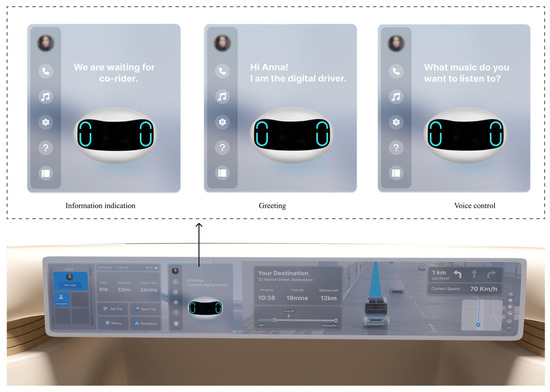
Figure 14.
A design example of the “AI Driver” on the interior “Main Screen”.
Integrating anthropomorphic features into both the exterior and interior design through physical and digital forms represents a unified design for the SAV concept. These design efforts aim to support passengers’ trust throughout the entire SAV experience by fostering a sense of emotional connection via anthropomorphic interaction.
6.2. Defensible Space
The design of an individual door for each space is intended to provide a sense of defensibility when passengers board or disembark the SAV. As shown in Figure 15, this concept includes group spaces and four private spaces within the SAV. The door eliminates intrusion into personal space during boarding and disembarking. Observation findings showed that, likely due to the vehicle’s capacity, there are rarely more than two passengers boarding or disembarking simultaneously at the same spot. Therefore, while there may be two or more strangers boarding or disembarking at the same location, this is expected to have a limited impact on the SAV journey.
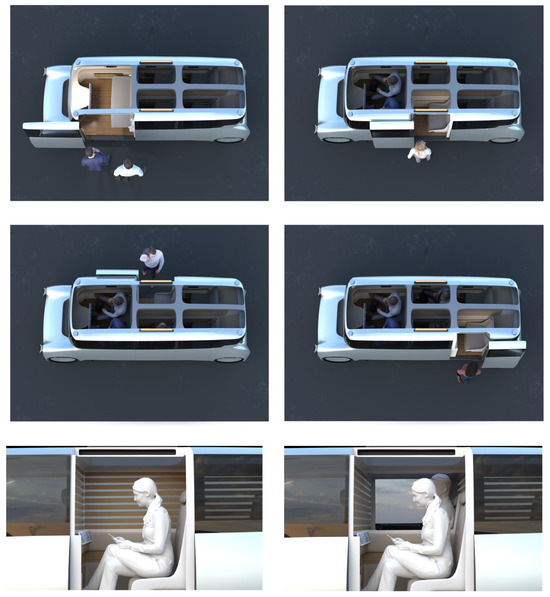
Figure 15.
Design solutions for defensible space.
The interior design introduces a flexible spatial configuration that allows passengers to customise their level of enclosure. This supports the perception of defensible space based on individual preferences. To achieve this, partitions are designed for the private spaces. These partitions can be adjusted by the passengers. For example, when a passenger books a private space, the default state of the partition is fully raised, creating an enclosed area for the passenger. Conversely, if passengers who are familiar with each other book two adjacent private spaces, the partition can be fully lowered to create a partially shared space for two passengers when their preferred settings “agree” to lower the partition. This design seeks to enhance the sense of territorial ownership for different user types, whether personal or group.
6.3. Design Outcome: System Transparency
System transparency is a key aspect of HMI design, commonly applied in traditional vehicles to display information through headlamps, signals, and driver gestures [24]. However, its application in SAVs remains underexplored. The final design focuses on how transparent information provision may contribute to building passenger trust in the absence of a driver.
From an exterior perspective, SAVs lack the subtle human cues of traditional drivers (e.g., gestures), so it is essential to clearly communicate vehicle status and intent. In this design, key information is displayed on the front, rear, and sides of the vehicle.
As shown in Figure 16a, the front and rear displays offer consistent details regardless of the passenger’s approach direction, including status indicators (e.g., stop/depart signals) and boarding guidance. Rear displays also serve as communication tools to indicate vehicle status to surrounding vehicles. Side screens across windows and wheels further support boarding and disembarking (Figure 16b). They display occupancy status, door-opening direction, and disembark alerts. Wheel screens complement this by showing boarding and departure cues. These features are designed to help reduce confusion and potential conflicts during shared use.
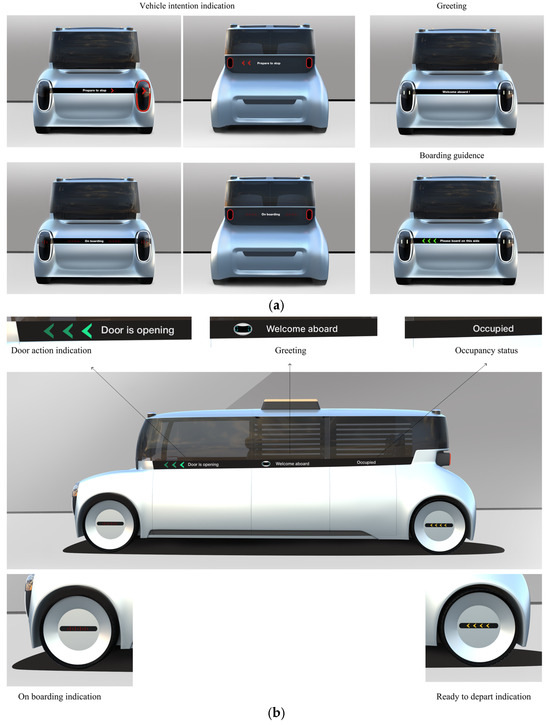
Figure 16.
Exterior interface design: (a) example of information display on front and rear face; (b) example of information display on side screen and wheel screen.
In the vehicle interior, each space is equipped with a personal “Main Screen” for displaying real-time trip and vehicle information. As seen in Figure 17, the left side of the screen provides trip summaries (e.g., fare, distance, occupancy), while the right displays navigation (e.g., route, upcoming stops, time remaining). This setup aims to support passenger awareness throughout the journey and may help to foster a greater sense of security.
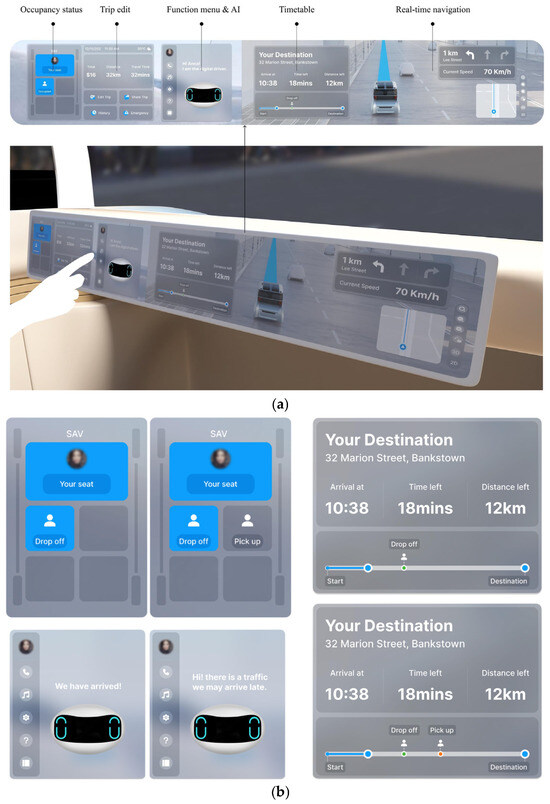
Figure 17.
Main Screen” interface design: (a) layout of interior “Main Screen” interface; (b) example of information display for interior “Main Screen”.
The design applies the principle of system transparency to propose potential solutions for information provision on both the exterior and interior HMI of the SAV. Clear communication between the vehicle and its occupants aims to enhance passengers’ sense of control. This increased understanding of the vehicle’s status and intentions throughout the different stages of the journey, including boarding and disembarking, may also contribute to building trust.
6.4. Design Outcome: Personalisation Feature
The concept of personalisation is implemented primarily through the “Space Control Screen”. As shown in Figure 18, each interior includes a control screen located on the door panel. This interface consolidates key space-related functions, including window control, climate adjustment, and lighting settings. It allows passengers to adjust the partition between seats, enabling the creation of a defensible space based on individual preferences. When adjacent passengers select compatible settings, the partition can be lowered to form a partially shared space.
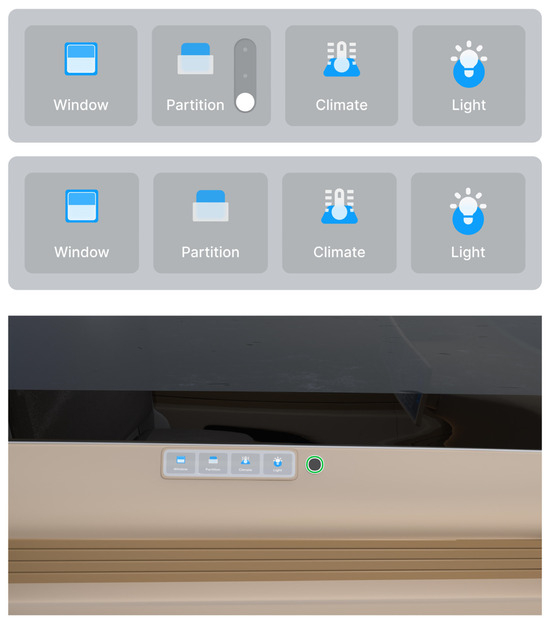
Figure 18.
Space control screen interface.
This personalisation feature complements the functionality of the “Main Screen” and enables intuitive control. By giving users greater autonomy over their immediate environment, it may enhance their overall sense of control and comfort during the ride.
6.5. Design Outcomes: Restorative Environment
Figure 19 shows the design solutions for creating a restorative environment in SAVs. Recognising the important relationship between spaces and different interior elements, the main concept was to create a home feeling for the passengers. The use of natural materials such as wood, along with a calm colour palette and organic form language, is intended to promote relaxation when passengers are seated in the space.
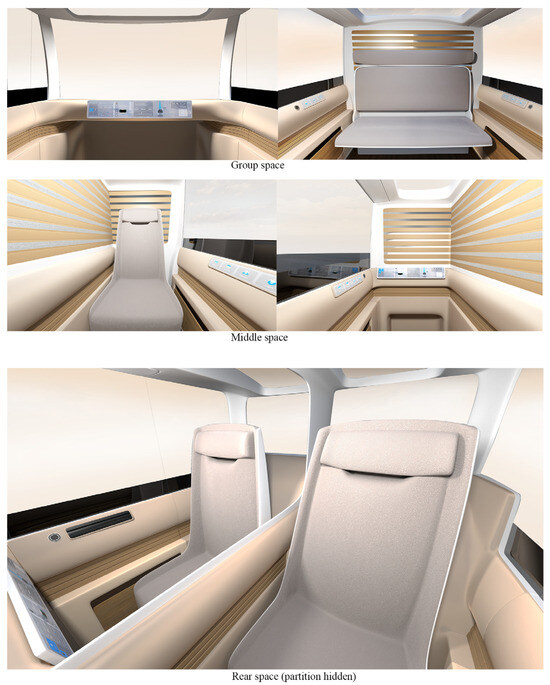
Figure 19.
SAV interior design.
An important element of the interior design is the seat. The final design is intended to create a sense of affinity through an integrated, sofa-like form, resulting in a shape that provides a comfortable feeling.
The seat shell is primarily constructed from ABS (Acrylonitrile Butadiene Styrene), a material widely used in the automotive industry for its high impact resistance, rigidity, ease of processing, and affordability [40]. The same material is also applied to the door panels and main interior structures, such as the headliner. Both the seat back and cushion use synthetic leather, selected for its durability, ease of cleaning, cost-effectiveness, and environmental advantages [41,42].
Building on the material design idea, another design aspect is the use of wood textures, primarily in the partitions. These textures are combined with frosted glass, which not only serves a functional role in creating visual separation and privacy but is also expected to help reduce feelings of confinement when the partitions are raised. This type of wood texture extends to other features throughout the interior, from front to back, enhancing the sensory effects aligned with the concept of embrace. A summary of the interior material indications is shown in Figure 20.
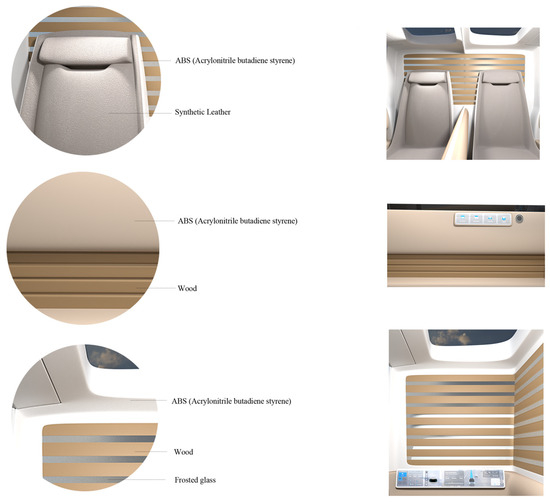
Figure 20.
Summary of interior material indications.
The main colour scheme for the interior is warm tones, primarily achieved through the natural hues of wood textures and other interior elements (e.g., door panels). The selective use of bright colours (e.g., white) is introduced to enhance the perceived spaciousness of the interior. Considering the impact of stain resistance on the restorative environment in a shared vehicle, the seat colour chosen is a warm grey, which harmonises well with other colours.
In response to the theory of restorative environments, this interior concept explores how various elements such as materials, colours and spatial forms can work together to support stress reduction and potentially contribute to a greater sense of passenger trust during the SAV journey.
7. Discussion
The literature shows that principles such as anthropomorphic design, defensible space, system transparency, personalisation features, and a restorative environment are important for building trust, either directly or indirectly. Accordingly, this study adopted a project-grounded methodology, combining an analysis of current ride-sharing user experiences to further explore how these design principles might be applied to the design of SAVs.
A summary of the design outcomes is presented in Table 3. It demonstrates how the final SAV design is achieved through the orchestration of physical and digital elements. Through iterative design practice, this project proposes a holistic concept that articulates how trust in SAVs could be influenced at various stages of the user journey by specific design interventions. These include visual language, spatial configuration, material choices, and interactive interface elements. The outcomes of this study offer valuable insights for both design practitioners and researchers, providing practice-based knowledge on how trust design theory can be effectively applied to various vehicle design elements within the broader context of automotive innovation.

Table 3.
Summary of design outcomes.
This project focuses on meeting users’ baseline trust requirements for SAVs through design. Future research can build upon the insights gained from this study by focusing more specifically on geographic regions in order to better understand and address localised trust requirements for SAVs and investigate how different design features address the needs of diverse markets. Once SAVs are deployed in real-world contexts, further research can explore user trust issues in actual usage scenarios to inform future design.
8. Conclusions
This project undertook a design practice to explore the design strategy of SAVs to enhance passengers’ trust in them. Following a project-grounded approach, a series of studio projects were conducted to explore potential solutions and gather diverse design insights and knowledge to address identified trust-related design enquiries. The outcomes suggest a set of design solutions that aim to integrate various elements related to trust in SAVs, including exterior and interior HMI features. This research contributes novel insights to the field of trust design for SAVs and has the potential to improve the understanding of trust design in the automotive sector, further refining related theoretical frameworks. Therefore, it is hoped that the findings of this study will provide valuable practical guidance for future designers and researchers.
Author Contributions
Conceptualisation, X.D.; methodology, X.D., S.C. and R.N.; software, X.D.; validation, X.D.; formal analysis, X.D.; investigation, X.D.; resources, S.C. and R.N.; data curation, X.D.; writing—original draft preparation, X.D.; writing—review and editing, X.D., S.C. and R.N.; visualisation, X.D.; supervision, S.C. and R.N.; project administration, X.D.; funding acquisition, S.C. All authors have read and agreed to the published version of the manuscript.
Funding
This research received no external funding. The Article Processing Charge (APC) was funded by the Monash Faculty of Art, Design and Architecture.
Institutional Review Board Statement
Not applicable.
Informed Consent Statement
Not applicable.
Data Availability Statement
The original contributions presented in this study are included in the article; further enquiries can be directed to the corresponding authors.
Conflicts of Interest
The authors declare no conflicts of interest.
References
- Golbabaei, F.; Yigitcanlar, T.; Bunker, J. The role of shared autonomous vehicle systems in delivering smart urban mobility: A systematic review of the literature. Int. J. Sustain. Transp. 2021, 15, 731–748. [Google Scholar] [CrossRef]
- Tian, L.-J.; Sheu, J.-B.; Huang, H.-J. The morning commute problem with endogenous shared autonomous vehicle penetration and parking space constraint. Transp. Res. Part B Methodol. 2019, 123, 258–278. [Google Scholar] [CrossRef]
- Narayanan, S.; Chaniotakis, E.; Antoniou, C. Factors affecting traffic flow efficiency implications of connected and autonomous vehicles: A review and policy recommendations. Adv. Transp. Policy Plan. 2020, 5, 1–50. [Google Scholar]
- Kim, S.; Chang, J.J.E.; Park, H.H.; Song, S.U.; Cha, C.B.; Kim, J.W.; Kang, N. Autonomous taxi service design and user experience. Int. J. Hum.–Comput. Interact. 2020, 36, 429–448. [Google Scholar] [CrossRef]
- Paddeu, D.; Parkhurst, G.; Shergold, I. Passenger comfort and trust on first-time use of a shared autonomous shuttle vehicle. Transp. Res. Part C Emerg. Technol. 2020, 115, 102604. [Google Scholar] [CrossRef]
- Merat, N.; Madigan, R.; Nordhoff, S. Human factors, user requirements, and user acceptance of ride-sharing in automated vehicles. In International Transport Forum Discussion Paper; OECD: Paris, France, 2017. [Google Scholar]
- Sarriera, J.M.; Germán, E.Á.; Kelly, B.; Andrew, A.; Timothy, S.; Jinhua, Z. To share or not to share: Investigating the social aspects of dynamic ridesharing. Transp. Res. Rec. 2017, 2605, 109–117. [Google Scholar] [CrossRef]
- Dichabeng, P.; Merat, N.; Markkula, G. Factors that influence the acceptance of future shared automated vehicles–A focus group study with United Kingdom drivers. Transp. Res. Part F Traffic Psychol. Behav. 2021, 82, 121–140. [Google Scholar] [CrossRef]
- Daniela, P.; Ioannis, T.; Graham, P.; Amalia, P.; Ian, S. A study of users’ preferences after a brief exposure in a Shared Autonomous Vehicle (SAV). Transp. Res. Procedia 2021, 52, 533–540. [Google Scholar]
- Hoff, K.A.; Bashir, M. Trust in automation: Integrating empirical evidence on factors that influence trust. Hum. Factors 2015, 57, 407–434. [Google Scholar] [CrossRef]
- Findeli, A. Searching for design research questions: Some conceptual clarifications. Questions. In Hypotheses & Conjectures: Discussions on Projects by Early Stage and Senior Design Researchers; iUniverse: Bloomington, IN, USA, 2010; Volume 2010, pp. 286–303. [Google Scholar]
- Council Design. A Study of the Design Process. 2007. Available online: https://www.designcouncil.org.uk/our-resources/archive/reports-resources/11-lessons-managing-design-global-brands/ (accessed on 10 July 2023).
- Candy, L.; Ernest, E.; Craig, V. Practice-based research. In The Routledge International Handbook of Practice-Based Research; Routledge: London, UK, 2021; pp. 27–41. [Google Scholar]
- Vom, B.; Jan, A.H.; Alexander, M. Introduction to design science research. In Design Science Research. Cases; Springer: Berlin/Heidelberg, Germany, 2020; pp. 1–13. [Google Scholar]
- Roesler, E.; Linda, O.; Julia, I.M. The effect of anthropomorphism and failure comprehensibility on human-robot trust. In Proceedings of the Human Factors and Ergonomics Society Annual Meeting, Online, 5–9 October 2020; SAGE Publications: Los Angeles, CA, USA, 2020; Volume 64, pp. 107–111. [Google Scholar]
- Sun, X.; Li, J.; Tang, P.; Zhou, S.; Peng, X.; Li, H.N.; Wang, Q. Exploring personalised autonomous vehicles to influence user trust. Cogn. Comput. 2020, 12, 1170–1186. [Google Scholar] [CrossRef]
- Becker, F.; Axhausen, K.W. Literature review on surveys investigating the acceptance of automated vehicles. Transportation 2017, 44, 1293–1306. [Google Scholar] [CrossRef]
- Chiou, E.K.; Lee, J.D. Trusting automation: Designing for responsivity and resilience. Hum. Factors 2023, 65, 137–165. [Google Scholar] [CrossRef] [PubMed]
- Lee, M.; Lee, Y. UI proposal for shared autonomous vehicles: Focusing on improving user’s trust. In Proceedings of the International Conference on Human-Computer Interaction, Virtual, 19–24 July 2020; Springer International Publishing: Cham, Switzerland, 2020; pp. 282–296. [Google Scholar]
- Martelaro, N.; Patrick, C.; Sarah, F.; Jodi, F. Designing an inclusive mobile app for people with disabilities to independently use autonomous vehicles. In Proceedings of the 14th International Conference on Automotive User Interfaces and Interactive Vehicular Applications, Seoul, Republic of Korea, 17–20 September 2022; pp. 45–55. [Google Scholar]
- Guest, G.; Emily, N.; Mario, C. A simple method to assess and report thematic saturation in qualitative research. PLoS ONE 2020, 15, e0232076. [Google Scholar] [CrossRef] [PubMed]
- Christou, P.A. How to use thematic analysis in qualitative research. J. Qual. Res. Tour. 2022, 3, 79–95. [Google Scholar] [CrossRef]
- Zhou, S.; Sun, X.; Liu, B.; Burnett, G. Factors affecting pedestrians’ trust in automated vehicles: Literature review and theoretical model. IEEE Trans. Hum.-Mach. Syst. 2021, 52, 490–500. [Google Scholar] [CrossRef]
- Oliveira, L.; Burns, C.; Luton, J.; Iyer, S.; Birrell, S. The influence of system transparency on trust: Evaluating interfaces in a highly automated vehicle. Transp. Res. Part F Traffic Psychol. Behav. 2020, 72, 280–296. [Google Scholar] [CrossRef]
- Vosooghi, R.; Puchinger, J.; Jankovic, M.; Vouillon, A. Shared autonomous vehicle simulation and service design. Transp. Res. Part C Emerg. Technol. 2019, 107, 15–33. [Google Scholar] [CrossRef]
- Lokhandwala, M.; Cai, H. Dynamic ride sharing using traditional taxis and shared autonomous taxis: A case study of NYC. Transp. Res. Part C Emerg. Technol. 2018, 97, 45–60. [Google Scholar] [CrossRef]
- Luccarelli, M.; Lienkamp, M.; Matt, D.; Spena, P.R. Automotive design quantification: Parameters defining exterior proportions according to car segment. In Proceedings of the SAE 2014 World Congress & Exhibition, Detroit, MI, USA, 8–10 April 2014; No. 2014-01-0357; SAE Technical Paper. [Google Scholar]
- Lee, G.; Taesu, K.; Hyeon-Jeong, S. GP22: A car styling dataset for automotive designers. In Proceedings of the IEEE/CVF Conference on Computer Vision and Pattern Recognition, New Orleans, LA, USA, 18–24 June 2022; pp. 2268–2272. [Google Scholar]
- Ceballos, L.M.; Nancy, N.H.; Kittichai, W. The MAYA principle as applied to apparel products: The effects of typicality and novelty on aesthetic preference. J. Fash. Mark. Manag. 2019, 23, 587–607. [Google Scholar] [CrossRef]
- Ceballos, L.M.; Nancy, N.H.; Kittichai, W. Consumer preference and apparel products: Investigating the role of the Centrality of Visual Product Aesthetics concept. Int. J. Fash. Des. Technol. Educ. 2021, 14, 325–337. [Google Scholar] [CrossRef]
- MMaeng, A.; Aggarwal, P. Facing dominance: Anthropomorphism and the effect of product face ratio on consumer preference. J. Consum. Res. 2018, 44, 1104–1122. [Google Scholar] [CrossRef]
- Wodehouse, A.; Ross, B.; Ed, B.; Alex, D. Pareidolia: Characterising facial anthropomorphism and its implications for product design. J. Des. Res. 2018, 16, 83–98. [Google Scholar]
- Wagner, A.; Kilincsoy, Ü.; Vink, P. Visual customization: Diversity in color preferences in the automotive interior and implications for interior design. Color Res. Appl. 2018, 43, 471–488. [Google Scholar] [CrossRef]
- Kaplan, R. The nature of the view from home: Psychological benefits. Environ. Behav. 2001, 33, 507–542. [Google Scholar] [CrossRef]
- Islas Muñoz, J.A.; Baha, S.E.; Muratovski, G. Radically Innovating the Automotive Design Process with Immersive Technologies. In DS 117, Proceedings of the 24th International Conference on Engineering and Product Design Education (E&PDE 2022); London South Bank University: London, UK, 2022. [Google Scholar]
- Pheasant, S.; Christine, M.H. Bodyspace: Anthropometry, Ergonomics and the Design of Work; CRC Press: Boca Raton, FL, USA, 2018. [Google Scholar]
- Demirel, H.O.; Ahmed, S.; Duffy, V.G. Digital human modeling: A review and reappraisal of origins, present, and expected future methods for representing humans computationally. Int. J. Hum.-Comput. Interact. 2022, 38, 897–937. [Google Scholar] [CrossRef]
- Stuart, M.; Geoff, W. H-Point: The Fundamentals of Car Design & Packaging; Design Studio Press: Los Angeles, CA, USA, 2014. [Google Scholar]
- Torre, I.; Carrigan, E.; McDonnell, R.; Domijan, K.; McCabe, K.; Harte, N. The effect of multimodal emotional expression and agent appearance on trust in human-agent interaction. In Proceedings of the 12th ACM SIGGRAPH Conference on Motion, Interaction and Games, Newcastle upon Tyne, UK, 28–30 October 2019; pp. 1–6. [Google Scholar]
- Wiese, M.; Thiede, S.; Herrmann, C. Rapid manufacturing of automotive polymer series parts: A systematic review of processes, materials and challenges. Addit. Manuf. 2020, 36, 101582. [Google Scholar] [CrossRef]
- Gurera, D.; Bhushan, B. Fabrication of bioinspired superliquiphobic synthetic leather with self-cleaning and low adhesion. Colloids Surf. A Physicochem. Eng. Asp. 2018, 545, 130–137. [Google Scholar] [CrossRef]
- Meyer, M.; Dietrich, S.; Schulz, H.; Mondschein, A. Comparison of the technical performance of leather, artificial leather, and trendy alternatives. Coatings 2021, 11, 226. [Google Scholar] [CrossRef]
Disclaimer/Publisher’s Note: The statements, opinions and data contained in all publications are solely those of the individual author(s) and contributor(s) and not of MDPI and/or the editor(s). MDPI and/or the editor(s) disclaim responsibility for any injury to people or property resulting from any ideas, methods, instructions or products referred to in the content. |
© 2025 by the authors. Licensee MDPI, Basel, Switzerland. This article is an open access article distributed under the terms and conditions of the Creative Commons Attribution (CC BY) license (https://creativecommons.org/licenses/by/4.0/).